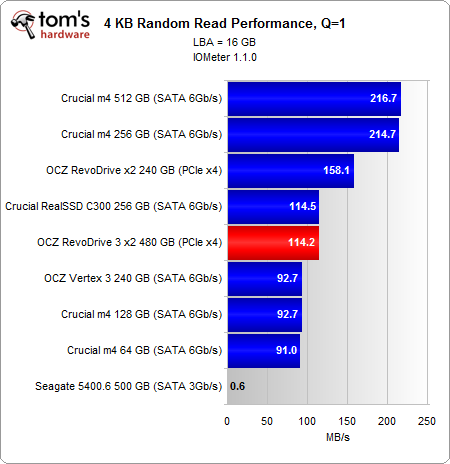The OCZ RevoDrive 3 X2 Preview: Second-Gen SandForce Goes PCIe
4 KB Random Performance: Throughput
Our Storage Bench v1.0 mixes random and sequential operations. However, it's still important to isolate 4 KB random performance, because that's such a large portion of what you're doing on a day-to-day basis. Right after Storage Bench v1.0, we subjected the drives to Iometer to test random 4 KB performance. But why specifically 4 KB?
When you open Firefox, browse multiple Web pages, and write a few documents, you're mostly performing small random read and write operations. The chart above comes from analyzing Storage Bench v.10, but it epitomizes what you'll see when you analyze any trace from a desktop computer. Notice that close to 70% of all of our accesses are eight sectors in size (512 bytes per sector, thus 4 KB).
We're restricting Iometer to test an LBA space of 16 GB because a fresh install of a 64-bit version of Windows 7 takes up nearly that amount of space. In a way, this examines the performance that you would see from accessing various scattered file dependencies, caches, and temporary files.
If you're a typical PC user, it's important to examine performance at a queue depth of one. However, the RevoDrive 3 X2 is anything but a typical SSD. OCZ envisions high queue depth use. That really shows up in the random read performance line graph.
At lower queue depths, the 256 GB and 512 GB m4s, 256 GB C300, and even the older RevoDrive X2 outpace the RevoDrive 3 X2. Once you move up to queue depths above eight, OCZ's latest PCIe SSD leaves everything else in the dust as it approaches 700 MB/s (~175 000 IOPS).
If you're a hard drive owner, this benchmark is really a worst-case scenario. Seagate's 5400.6 only achieves random reads of 0.6 MB/s random read rate, 150x slower than the 64 GB m4.
The RevoDrive 3 X2 performs better in random writes. Even at a queue depth of one, its write rate of 224.6 MB/s is only outpaced by the 256 GB and 512 GB m4s. However, the margin of difference is very small among the top five SSDs. The RevoDrive 3 X2 really starts to make its stand once you look at queue depths above four. At a queue depth of eight, you're almost pushing 800 MB/s (~200 000 IOPs).
Get Tom's Hardware's best news and in-depth reviews, straight to your inbox.
Current page: 4 KB Random Performance: Throughput
Prev Page Storage Bench v1.0: Real-World Analysis Next Page 4 KB Random Performance: Response Time-
warmon6 ReplyIt's not a business-class product. It's for the power user who is able to tax it using the right workload. If you're not one of those folks, the RevoDrive 3 X2 is seriously overkill.
OVERKILL?!?!
Nothing is overkill in the computer arena in terms of performance. :p
Just the price can be over kill. o.0 -
acku Santa is going to need a bigger expense account... :)Reply
Personally, I'm hoping that OCZ adds TRIM prior to September.
Cheers,
Andrew Ku
TomsHardware.com -
greenrider02 I saw defense of the Vertex 3's occasional low numbers, but no mention of the solid (and sometimes better) performance that the cheaper and more miserly Crucial m4 showed throughout your tests.Reply
Perhaps you have some bias towards the Vertex 3 that needs reconsideration?
Other than that, $700 seems like a fair price when considering the performace difference, especially if utilized properly, for instance as a high traffic web/corporate server -
acku greenrider02I saw defense of the Vertex 3's occasional low numbers, but no mention of the solid (and sometimes better) performance that the cheaper and more miserly Crucial m4 showed throughout your tests.Perhaps you have some bias towards the Vertex 3 that needs reconsideration?Other than that, $700 seems like a fair price when considering the performace difference, especially if utilized properly, for instance as a high traffic web/corporate serverReply
If you read the first page then you know that I give a nod to Vertex 3s as the fastest MLC based 2.5" SSD. I consider that plenty of love. :).
We'll discuss the lower capacity m4s in another article. FYI, I suggest that you read page 5 and page 6. We are not testing FOB. We are testing steady state. That's part of the reason the SF-based drives are behaving differently with incompressible data.
On your second point, this is in no way targeted toward an enterprise environment (that's what Z-drives are for). There is no redundancy in the array if a single SF controller fails. The whole card is a dud afterward. You can add higher level redundancy, but enterprise customers have so far been nervous on SandForce products. Plus, there's a general preference for hardware vs. software redundancy. (That's them talking not me). Overall, this makes it unacceptable for any enterprise class workload.




